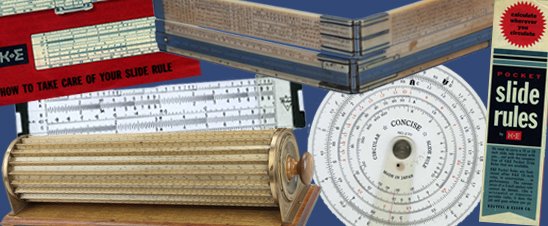This ten-inch mahogany duplex slide rule is coated with white celluloid. There are LL02, LL03, DF, D, LL3, and LL2 scales on one side of the base, with CF, CIF, CI, and C scales on the slide. The right side of the slide is marked in red: © (/) K + E.
- Description
-
This ten-inch mahogany duplex slide rule is coated with white celluloid. There are LL02, LL03, DF, D, LL3, and LL2 scales on one side of the base, with CF, CIF, CI, and C scales on the slide. The right side of the slide is marked in red: © (/) K + E. On the other side of the base, there are LL01, L, K, A, D, DI, and LL1 scales, with B, T, ST, and S scales on the slide. The left end of the slide is marked: 410923. The left end of the top and the bottom of the base are both marked: 923. The indicator is glass, with white plastic edges held together with metal screws. Keuffel & Esser used this arrangement of scales from 1954 to 1962.
-
The top edge of the rule is marked: PATS. PEND. MADE IN U.S.A. 4080-3 LOG LOG DUPLEX TRIG ® COPYRIGHT 1947 BY KEUFFEL & ESSER CO. PATS. 2,500,460 2,168,056 2,170,144 2,285,722 2,422,649. These patents were issued between 1939 and 1950. They dealt with the arrangement of scales on a slide rule, in particular so that the user could solve multistep problems without having to write down intermediate settings, and with the placement of a legend to make placing the decimal point easier.
-
The rule fits into an orange leather case lined with chamois, which is marked on the flap: K + E. The case fits inside a green cardboard box, which has been completely wrapped in masking tape. See 2007.0181.01.01 for documentation received in the box. A label on the end of the box is marked: K + E (/) 68 1215 (/) LOG LOG DUPLEX DECITRIG (/) SLIDE RULE (/) WITH LEATHER CASE. The label is also marked: OLD (/) 4081-3S. The S indicates the sewn leather case. K&E's model 4081 differed from the 4080 in that the trigonometric scales were given in degrees and decimals of a degree instead of in degrees and minutes. In 1962, the model numbers were changed and given the prefix "68," and the ST scale was changed to an SRT scale. The 4080 with a sewn leather case would have been model 68-1318 in the new system. Thus, the rule was made before 1962 and the box was made after 1962. The serial number on the rule is consistent with a manufacturing date in the late 1950s.
-
The donor, Marvin Coolidge, reported that he purchased this rule in the fall of 1963 for use in a one-year slide rule course during college. He subsequently enlisted in the U.S. Air Force, where he was trained in electronics repair, a field that did not require use of this slide rule.
-
References: Carl M. Bernegau, "Slide Rule" (U.S. Patent 2,168,056 issued August 1, 1939); Lyman M. Kells, Willis F. Kern, and James R. Bland, "Slide Rule" (U.S. Patent 2,170,144 issued August 22, 1939); Lyman M. Kells, Willis F. Kern, and James R. Bland, "Slide Rule" (U.S. Patent 2,285,722 issued June 9, 1942); James R. Bland, "Slide Rule" (U.S. Patent 2,422,649 issued June 17, 1947); Herschel Hunt, "Slide Rule" (U.S. Patent 2,500,460 issued March 14, 1950); K + E Catalog, 42nd ed. (New York: Keuffel & Esser Co., 1954), 279; Keuffel & Esser Co., Slide Rules, Catalog 8 (Hoboken, N.J., 1962), 8-17; Clark McCoy, "Collection of Pages from K&E Catalogs for the 4081-3 Family of Slide Rules: 4080-3 & 4081-3 Family Groups," http://www.mccoys-kecatalogs.com/KEModels/ke4081-3family.htm; Walter Shawlee II, Ted Hume, and Paul Ross, "Keuffel & Esser Co. Slide Rules," Sphere Research Corporation, http://www.sphere.bc.ca/test/ke-sliderule.html.
- Location
-
Currently not on view
- date made
-
1954-1962
- maker
-
Keuffel & Esser Co.
- ID Number
-
2007.0181.01
- accession number
-
2007.0181
- catalog number
-
2007.0181.01
